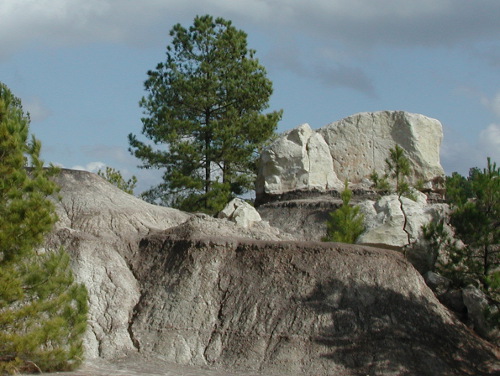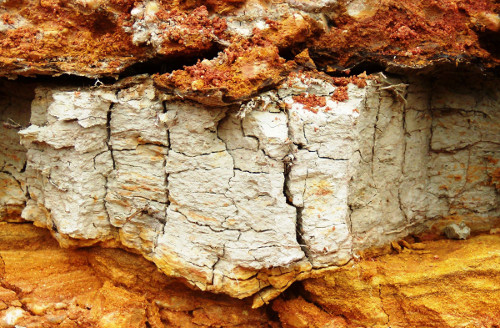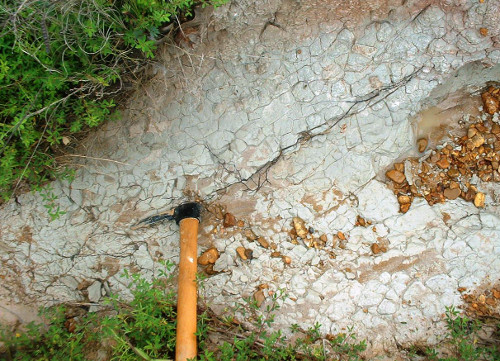Clay
Clay is a major industrial mineral resource in Arkansas. Combined industry output in 2005 amounted to over 1.2 million tons of raw clay, valued at over $1.9 million. In 2005, Arkansas ranked 6th in the nation in production of common clays. Few data concerning tonnage and grade of individual clay deposits in Arkansas are available, but the amount of potentially useful clay in Arkansas is substantial.



Over the past two decades, the brick industry of Arkansas has consolidated to one major producer, Acme Brick of Perla in Hot Spring County. Sandy kaolinitic clays of the Wilcox Formation (Eocene) are the source of the bulk of common clay in Arkansas. Wilcox clays, alone or mixed with clay from other geologic units, are usable for most ceramic products, especially refractory brick and heavy clay products. Deposits in the Wilcox Group in Hot Spring, Ouachita, and Hempstead Counties have been particularly important. Some building brick has also been manufactured from surface clays and shales in other regions of the state.
Beginning in the early 1950's, bloating clay was expanded for lightweight aggregate at Poyen, Grant County. Alluvial clay suitable for lightweight aggregate has been mined near England, Lonoke County, and was recently being mined in Crittenden County. Most of the physiographic provinces of the state contain major resources of this material. In the Ozark region, black fissile shales of the Atoka Formation (Pennsylvanian) constitute a major potential resource. In the Arkansas Valley, clays derived by the weathering of shales in the Hartshorne Sandstone are potentially useful. The bloating-clay resources of the West Gulf Coastal Plain include tuffaceous sediments of the Woodbine Formation (Cretaceous), Brownstown Marl (Cretaceous) and some clays of the Wilcox Group (Eocene). Smectite clays in Arkansas have received some attention for use as commercial grade "kitty litter". Such clays are common in the Midway Group (Tertiary) in central Arkansas and in several Cretaceous formations in southwestern Arkansas. High bloating characteristics with a medium firing range result in a frothy porosity which is ideal for a high-absorbency product. The Mississippi River Alluvial Plain contains major resources, including surficial alluvial (recent stream) deposits and the loess (wind-blown dust) deposits of Crowley's Ridge. Few detailed studies of reserves of individual deposits have been done, but Arkansas's potential reserves of clay (and shale) that qualify for bloating appear large.
Clays having the properties necessary for pottery and stoneware use are present in the Ouachita Mountain and Arkansas Valley regions and were formed by the weathering of shales in the Atoka Formation and Stanley Shale (Pennsylvanian and Mississippian, respectively). Most Cretaceous clays in southwest Arkansas are calcareous and are not suitable for ceramic purposes. Ceramic and pottery clays occur in southeastern Arkansas, primarily in the Midway Group (Paleocene), and the Wilcox and Jackson Groups (both Eocene) and in Quaternary sediments.
In the Gulf Coastal Plain region, fire clays have been mined from kaolin deposits in the Tokio Formation (Cretaceous) in Pike County. Some fire clays (as underclays), associated with lignite, are locally present in the Wilcox Group. Some Wilcox clays in Ouachita and Hot Spring Counties are suitable for manufacturing fire brick. High-alumina clays, associated with bauxite deposits in Pulaski and Saline Counties in central Arkansas, are potential sources for refractory materials.
Changes have occurred in the various clay industries in recent years. Some changes are due to technological advances, changing economic conditions, opening new markets, shifts in demand, and increases in both domestic and export markets. Changing conditions which affect the clay industry in Arkansas include increasing freight rates, energy costs, production and marketing costs, and governmental control (mining laws). An example of this changing situation is the public's attitude towards landfills. At one time, rubbish disposal did not require containment of the liquid products of any landfill, but it does today. Clay liners are commonly installed during landfill construction. The types of clay used vary according to the type of material the landfill will contain. Untreated clays used industrially as clay liners include kaolinite, smectite, and palygorskite. Each clay has very different physical and chemical properties, allowing their use as liners in differing situations.
Bentonite
The principal clay mineral composing bentonite is smectite. Smectite is most often used as a group name, encompassing a number of very fine grained minerals which possess certain ion-exchange characteristics. Bentonite's commercial value is due to its ion-exchange ability, which determines the clay's physical expansion and colloidal properties. Sodium-rich bentonites are valuable for well-drilling muds which must flow when shaken or stirred, but harden when left undisturbed (thixotropy).
Bentonite occurs as bedded deposits and as a hydrothermal mineral. Bentonite beds that originated as an alteration of waterlaid volcanic ash, deposited in either fresh or saline water, are commercially the most important source of this resource. In the Gulf Coastal Plain of Arkansas, beds of bentonite are present in the Midway Group (Paleocene). Several of these bentonitic beds contain fuller's earth. Bentonite has not been mined in Arkansas, although small deposits of certain clays that have the desired bentonitic properties after treatment have been mined.
Bloating Clay
Bloating clay may be defined as any fine-grained clayey material which, upon firing, expands or bloats into a frothy mass with closed cellular texture within a limited temperature range. In practice, the definition can be extended to include some shales, slates, and mine wastes. After being ground to fine size and mixed with water, some of these particles are clayey and can be used as feedstock for making lightweight aggregate. The property of expansion upon firing is desired because bloated material, when used as an aggregate in concrete, reduces the weight of the final product. Two conditions are necessary to bring about bloating. During firing, when the bloating temperature is reached, the general clayey mass must be in a plastic condition and, simultaneously, gases must be evolving throughout the mass. Plasticity is developed by the fluxes that start a fusion and, in this state, the gases can not readily escape. The result is a mass of thin-walled cells, resembling pumice in appearance. After firing, the expanded clay is ground or broken to various sizes and is used in concrete structures, lightweight building block, and precast or prestressed concrete structural members. The use of lightweight aggregates results in considerable monetary savings in structural steel and foundation design on new and existing structures, and in some applications, strength is greater than it would be if heavier rock aggregate were used. Other applications include loose insulation, plaster and stucco aggregate, mulching agents for horticultural applications, bases for sports tracks, and refractory (high temperature) materials.
Briefly, beginning in the early 1950's, clay was expanded for lightweight aggregate at Poyen, Grant County. Alluvial clay suitable for lightweight aggregate has been mined near England, Lonoke County, and is currently being mined in Crittenden County. Most of the physiographic provinces of the state contain major resources of this material. In the Ozark region, black fissile shales of the Atoka Formation (Pennsylvanian) constitute a major potential resource. In the Arkansas Valley, clays derived by the weathering of shales in the Hartshorne Sandstone are potentially useful. The bloating-clay resources of the West Gulf Coastal Plain include tuffaceous sediments of the Woodbine Formation (Cretaceous), Brownstown Marl (Cretaceous) and some clays of the Wilcox Group (Eocene). Smectite clays in Arkansas have received some attention for use as commercial grade "kitty litter". Such clays are common in the Midway Group (Tertiary) in central Arkansas and in several Cretaceous formations in southwestern Arkansas. High bloating characteristics with a medium firing range result in a frothy porosity which is ideal for a high-absorbency product. The Mississippi River Alluvial Plain contains major resources, including surficial alluvial (recent stream) deposits and the loess (wind-blown dust) deposits of Crowley's Ridge. Few detailed studies of reserves of individual deposits have been done, but Arkansas's potential reserves of clay (and shale) that qualify for bloating appear large. A potential source of lightweight aggregate in Arkansas is tripoli (see Tripoli).
Common Clay
Clay suitable for the manufacture of heavy clay products, such as building and paving bricks, drain tile, and sewer tile, are present in several areas of the state and have been utilized for many years. Many deposits of kaolin, ball clay, and fire clay are suitable for heavy clay products. To manufacture heavy clay products, the natural material must possess certain working and drying properties, the most important include plasticity when wet, little shrinkage when drying and being fired, and good strength as both a green (unfired) and fired product. The fired color of the clay is important to both the consumer and manufacturer. A building-brick clay that fires white may be developed commercially because, by the addition of various minerals, the color may be modified to meet whatever is popular among consumers. Clay from another deposit, otherwise comparable in size and clay quality, that fires to a red to orange color may not be commercially suitable for the brick industry, but may be considered usable by the manufacturer of unglazed clay flower pots.
Geologically and volumetrically, the most important source of clay in Arkansas is the Wilcox Group (Eocene). Wilcox clays, alone or mixed with clay from other geologic units, are usable for most ceramic products, especially refractory brick and heavy clay products. Deposits in the Wilcox Group in Hot Spring, Ouachita, and Hempstead Counties have been particularly important. Some building brick has also been manufactured from surface clays and shales in other regions of the state.
Fuller's Earth
Fuller's earth, or natural bleaching clay, is any natural or treated clay which, when used as a filter, effectively removes color and clarifies various mineral and organic oils. Mineralogically, fuller's earth is predominantly smectite (calcium montmorillonite), but typically includes some kaolinite and attapulgite. The importance of fuller's earth to industry is due to its bleaching properties. Deposits of fuller's earth were mined by underground methods near Olsen Switch, 7 miles south of Benton in Saline County, between 1901 and 1922. The deposits were formed by the weathering of igneous dikes of Cretaceous age. The original igneous rock was altered to a depth of 200 feet, probably in early Tertiary time, while bauxite was forming nearby. Several deposits of bentonite, which upon treatment with weak acid have good bleaching or clarifying properties, are reported in Pulaski and Saline Counties. These bedded deposits are in the Midway and Wilcox Groups (Paleocene and Eocene, respectively)
High-purity Kaolin
Kaolin has numerous industrial applications and new uses continue to be discovered. It is a unique industrial mineral due to several properties, including chemical inertness over a wide range of acid-alkaline conditions, white color, good covering or hiding power when used as a pigment or extender in coated films and in paper-filling applications, softness and non-abrasive properties, low conductivity of heat and electricity, and lower cost than most competitive materials. Some uses of kaolin require very rigid specifications including particle-size distribution, color and brightness, and viscosity. Other applications require none of these, an example being the use of kaolin in the manufacture of cement. Nationally, the higher grades of kaolin compose the bulk of the tonnage sold and have the highest unit value. Many grades are designed for specific uses, particularly for the paper, paint, rubber, plastics, and ceramics industries. Deposits of high-purity kaolin have been and will continue to be sought in Arkansas. Currently, no deposits have been discovered that are suitable to the paper industry, but continuing research into the uses and applications of kaolin may result in expanded use.
Pottery Clay
Clays used for pottery and stoneware are principally kaolin and/or ball clay. To be successfully worked and dried, the clay must be plastic when wet, shrink little while drying, and resist warping and breaking after being dried before firing. At this stage, it is known as "greenware". After firing, the final product must be hard, strong, nonporous and of suitable color. Household items manufactured using pottery clays include porcelain sinks and waterclosets (toilets), some chinaware, various types of ovenproof cookware, stoneware and other kitchen and dinnerware, ceramic floor and wall tile, and decorative items. Pottery has been manufactured from red-orange residual clays in the Ozark Plateaus region of Arkansas. Clays having the properties necessary for pottery and stoneware use are present in the Ouachita Mountain and Arkansas Valley regions and were formed by the weathering of shales in the Atoka Formation and Stanley Shale (Pennsylvanian and Mississippian, respectively). Most Cretaceous clays in southwest Arkansas are calcareous and are not suitable for ceramic purposes. Ceramic and pottery clays occur in southeastern Arkansas, primarily in the Midway Group (Paleocene), and the Wilcox and Jackson Groups (both Eocene) and in Quaternary sediments.
Refractory Clay
Refractory clays exhibit a range of high melting temperatures which make them useful wherever high-temperature applications exist. Refractory bricks line the roasting and processing furnaces of various high-temperature processing plants and ceramic kilns, and compose crucibles, condensers, and many types of laboratory glassware. The white ceramic insulator portion of gasoline engine spark plugs are manufactured from refractory clay and coated with vitrified kyanite (Al2SiO5). In addition to the high melting temperatures, refractory clays must have good greenware strength and exhibit minimum shrinkage and warpage. Kaolinite, flint clay, plastic fire clay, ball clay, and various calcined materials, such as bauxite, qualify as refractory resources. The product is generally hard and may vary in porosity. In the Ozark region of Arkansas, some shales in the Atoka Formation (Pennsylvanian) have the firing properties necessary to manufacture refractory materials such as fire brick. Clays generated from weathered Pennsylvanian strata in the Arkansas Valley constitute abundant fire-clay resources. These clays are often underclays associated with coal beds. Although the shale units of the Ouachita Mountain region are highly varied, fire clay resources are present. In the Gulf Coastal Plain region, fire clays have been mined from kaolin deposits in the Tokio Formation (Cretaceous) in Pike County. Some fire clays (as underclays), associated with lignite, are locally present in the Wilcox Group. Some Wilcox clays in Ouachita and Hot Spring Counties are suitable for manufacturing fire brick. High-alumina clays, associated with bauxite deposits in Pulaski and Saline Counties in central Arkansas, are potential sources for refractory materials.
Arkansas clay resource
Clay is a major industrial mineral resource in Arkansas. Combined industry output in 1995 amounted to over 1 million tons of raw clay, valued at over $1.2 million. In 1995, Arkansas ranked 4th in the nation in production of both kaolin and fire clays, and 9th in common clays. Few data concerning tonnage and grade of individual clay deposits in Arkansas are available, but the amount of potentially useful clay in Arkansas is substantial. Changes have ocurred in the various clay industries in recent years. Some changes are due to technological advances, changing economic conditions, opening new markets, shifts in demand, and increases in both domestic and export markets. Changing conditions which affect the clay industry in Arkansas include increasing freight rates, energy costs, production and marketing costs, and governmental control (mining laws). An example of this changing situation is the public's attitude towards landfills. At one time, rubbish disposal did not require containment of the liquid products of any landfill, but it does today. Clay liners are commonly installed during landfill construction. The types of clay used vary according to the type of material the landfill will contain. Untreated clays used industrially as clay liners include kaolinite, smectite, and palygorskite. Each clay has very different physical and chemical properties, allowing their use as liners in differing situations.
References
Branner, J. C., 1908, The clays of Arkansas: U. S. Geological Survey Bulletin 351, 247 p.
Miser, H. D., 1913, Developed deposits of fuller's earth in Arkansas: U. S. Geological Survey Bulletin 530, p. 207-220.
Williams, N. F., and Plummer, Norman, 1951, Clay resources of the Wilcox group in Arkansas: Arkansas Resource and Development Commission, Division of Geology, 98 p.